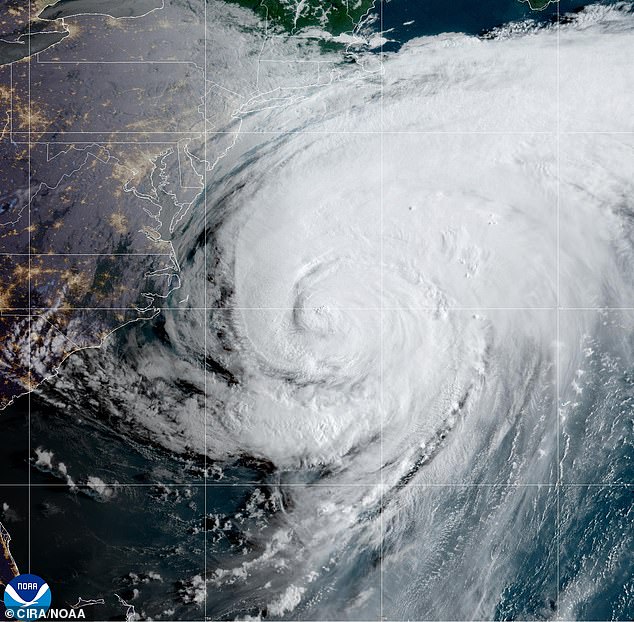Hurricane Erin has shifted north, posing significant risks of destructive surf, powerful rip currents and coastal flooding along the Mid-Atlantic and Northeast shorelines.
The National Weather Service (NWS) issued coastal flood warnings on Thursday for residents across parts of Virginia, Maryland, Delaware, New Jersey and Long Island, New York.
Erin is expected to generate large breaking waves of 8 to 16 feet and life-threatening rip currents along the coast through Friday evening, with High Surf Advisories and Beach Hazards Statements in effect.
Coastal flood warnings project 1 to 3 feet of inundation above ground level in low-lying areas, with the most severe impacts expected during Thursday evening’s high tide.
Residents should prepare for widespread road closures, potential flooding of homes and businesses, and significant erosion of beaches and dunes, particularly in vulnerable coastal communities.
The NWS advised avoiding flooded roads and staying out of the surf due to dangerous conditions that could lead to property damage and pose risks to life.
‘Take the necessary actions to protect flood-prone property. If travel is required, do not drive around barricades or through water of unknown depth,’ the NWS said.
‘The surf will be extremely dangerous for everyone, and swimming is absolutely discouraged.

Hurricane Erin is making its way further up north, threatening millions of Americans with life-threatening rip currents, destructive surf and damaging coastal flooding
Hurricane Erin is not expected to make landfall along the East Coast, but dangerous conditions are hitting areas like North Carolina’s Outer Banks.
Tens of thousands were evacuated from the most vulnerable barrier islands as storm surges of up to 4 feet threatened the region.
The storm’s center and peak winds remained about 200 miles east-southeast of Cape Hatteras as of 5am, and tropical-storm-force winds extended up to 320 miles, affecting parts of North Carolina and Virginia.
The central Outer Banks faced the brunt of the storm, with waves up to 20 feet and surges of 2 to 4 feet overwhelming some islands.
A Tropical Storm Warning has been issued in parts of Delaware, Maryland, New Jersey, North Carolina and Virginia.
The NWS also noted that Connecticut, Delaware, Florida, Georgia, Maryland, Massachusetts, New Jersey, New York, North Carolina, Rhode Island, South Carolina and Virginia are under a High Surf Advisory.
From Virginia Beach to Ocean City, Maryland, major coastal flooding is expected during high tides through Thursday, with waves up to 14 feet, rip currents, and beach erosion likely to close roads and inundate homes and businesses.
The Chesapeake Bay region could see water levels rise up to three feet, while Delaware and New Jersey face one to two feet of flooding and dangerous surf, especially Thursday evening.

Parts of North Carolina (PICTURED) were evacuated earlier this week ahead of the Erin, which flooded beaches

The National Weather Service (NWS) issued coastal flood warnings on Thursday for residents across parts of Virginia, Maryland, Delaware, New Jersey and Long Island, New York

Erin is not expected to make landfall as it moves north over the Atlantic Ocean
‘The sea will be quite angry,’ wrote the NWS in Mt Holly, New Jersey.
Meteorologists warned that the highest impacts of Hurricane Erin are expected to hit the Jersey Shore and Delaware beaches during the afternoon and evening hours on Thursday, with dangerous surf and flooding expected.
Several counties are already under alerts, including a coastal flood warning through 2am Saturday, a wind advisory from 10am Thursday to midnight Friday and a rip current warning in effect until 8pm Friday.
Read More
Scientists issue urgent warning over ‘doomsday tsunami’ set to hit parts of the US… is your hometown at risk?

New Jersey Gov. Phil Murphy held a press briefing Tuesday morning to warn of strong rip currents and high surf from Hurricane Erin, while noting that overall weather should remain pleasant as the storm moves offshore.
‘We are worried, therefore, in a big way, about human nature and complacency,’ Murphy said.
‘We’ve already had a very tough riptide summer, particularly over the past several weeks.’
He then referenced the two drowning incidents over the past few weeks in Seaside Heights and Belmar.
Farther north, New York and New England are under high surf advisories, with waves up to 16 feet threatening dune erosion and localized flooding along Long Island and Cape Cod.
Erin is forecast to track well south of Nova Scotia and Newfoundland from Friday into Saturday, but rough, dangerous seas will still pound southern coastlines.
